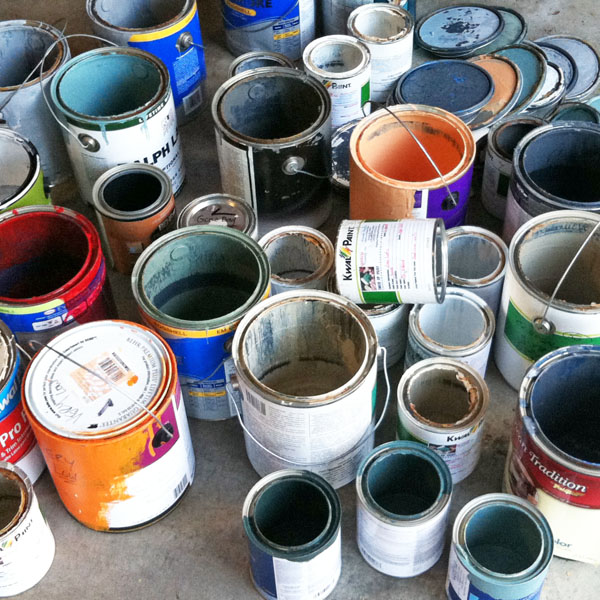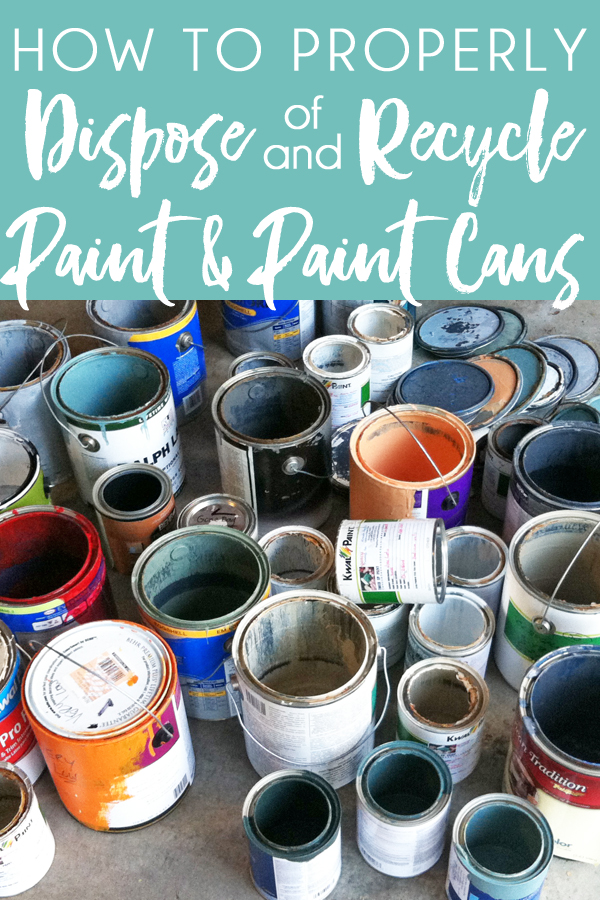As a serial DIYer, I’m always repainting the walls in our house, and painting just about everything else in sight with spray paint. That leaves us with a lot of leftover paint and, in time, a lot of empty paint cans. We have a very small utility room and a detached, unheated garage, so I had a lot of questions about how and where I could safely store my leftover paint, and how to properly dispose of paint and paint cans.
I did a lot of research regarding both paint storage and disposal options, and learned that we could recycle some of our leftover paint, as well as recycling all of our empty paint cans. Today I’m sharing all the findings of my research with some helpful tips for how to store leftover paint, how to dispose of leftover paint, and how to recycle paint cans.
HOW & WHERE TO STORE LEFTOVER PAINT
How to Store Latex Paint
- Transfer left-over paint to airtight containers. Air is the enemy of latex paint. Latex paint is water-based, and water-based paints contain ammonia. Ammonia vapor attacks the protective lining of paint cans, leading to rust that can damage paint. Transferring left-over paint to airtight plastic containers eliminates the rust problem, extending the life of the latex paint.
- If storing paint in the original cans, ensure a tight seal. Wipe as much excess paint as possible off of the rim before closing the can. Stretch a piece of plastic wrap over the rim before replacing the lid. When replacing the lid, don’t hammer it in place, as this can dent the rim or lid allowing more air to enter. Instead, put a piece of scrap wood on top of the lid then tap with a mallet to seal the lid back in place. Avoid storing paint cans directly on a cement floor, as the bottom of the can will rust much faster on cement than on other surfaces.
- Store Paint Away from Extreme Temperatures. Avoid storing paint in locations that are likely to get too hot or too cold. Freezing temperatures are particularly damaging to latex paint, so avoid storing paint in an un-insulated garage or storage shed. If you must store paint in such locations, keep the paint on a shelf, and off any tile or concrete floors to avoid constant contact with the ground which will drop the temperature more quickly and lead to repeated freezing and thawing. Extreme heat can also damage the pigments in latex paint, so avoid storing paint in areas that are likely to get too hot, such as near a furnace or water heater if the room is not temperature controlled. (We are storing our latex paint in our utility room near our furnace and water heater, but the room is well ventilated and temperature controlled.)
- Determine if Paint is Still Good Before Using. There is no set answer to how long you can store latex paint. The most important thing is to ensure that you paint is still good before using it. Paint separation can occur regardless of the quality of the paint and the paint storage method. Color enhancers separate, but if the ingredients easily combine, and the paint does not show signs of livering (rubbery or coagulating), it may still be good. Usable paint should be creamy and have no lumps. After thoroughly mixing, if the paint remains lumpy, is too thick or too thin, or does not have a consistent color, it has likely gone bad. If the paint has gone bad, read the tips below for proper disposal.
Storing Oil-Based Paint & Spray Paint Storage
- How to Determine if Paint is “Oil-Based.” Oil-based paints include enamels, varnishes, shellacs, lacquers, stains and sealers. After reading the label, or if the label is missing or illegible, treat paint as oil-based for the purposes of safe storage and proper disposal, as outlined below.
- Read Labels Closely. Read the paint labels closely to determine whether each particular paint or paint product is flammable or combustible when determining where to safely store the paint. In reading the labels of our paint cans, for example, we discovered that the magnetic primer (which we used when creating our chalkboard wall) is highly flammable.
- Store Oil-Based Paint and Spray Paint Away from Heat Sources and Open Flames. It is unsafe to store oil-based paint, spray paint, or any other paints that are flammable or combustible, near any devise with a pilot light. The vapors can ignite and cause a fire, a flashover or an explosion. Read about the creative and space saving solution to store and organize my spray paint cans.
PAINT & PAINT CAN DISPOSAL & RECYCLING TIPS
Look for Alternatives to Paint Disposal First
If you have good, unwanted paint, consider giving it to an organization that can use it, such as a local charity or community groups, a high school or community theater, or a Habitat for Humanity ReStore.
How to Properly Dispose of and Recycle Paint and Paint Cans
- Recycling Unused Liquid Latex Paint is the Best Option. There are numerous organizations that offer latex paint recycling. In Colorado, a company called Green Sheen recycles liquid latex paint and reprocesses it into new colors of paint that are then resold at lower costs than new paint. Not only is this an environmentally friendly option, but it is also much more cost effective (Green Sheen charges only $3 per gallon) as compared to disposal at a Household Hazardous Waste site (a minimum of $15 in Denver) where the paint likely ends up permanently in a landfill. Green Sheen a drop-off site in central Denver, and will even pick up the paint from your home for a small fee. Some Ace Hardware store locations have also begun offering paint recycling, so check with your local store. Otherwise, do an internet search for paint recycling companies and sites in your area.
- If You are Unable to Locate a Paint Recycling Company in Your Area, You Must Ensure that the Paint is Disposed of Properly. Many counties and states consider latex paint to be a hazardous material, requiring that excess latex paint be disposed of at designated Household Hazardous Waste (HHW) sites. To find a HHW site near you, call you City Hall, check your city’s website, or check online at Earth911 and input the word paint and your zip code in the appropriate boxes. If there is not a HHW site near you, then contact the regional EPA office responsible for your state or contact your state Department of Environmental Quality. Keep in mind that disposal of paint at a HHW site is typically not free. Additionally, be aware that most of this paint is not recycled and ends up going into a hazardous material landfill.
- If Your County or State Does Not Consider Latex Paint to be a Household Hazardous Waste, You Must Make the Paint into a Solid Before Disposing of it in the Trash. A dry product called “Paint Hardener” can be added to old cans of paint to make the paint hard and acceptable for disposal in the trash. Paint Hardener, or Waste Paint Hardener, as it is sometimes called, is sold at most hardware and some home improvement stores. As an alternative to Paint Hardener, you can pour the unused latex paint into a container of non-flammable absorbent material, such as cat litter or sawdust and then allow it to dry. This works best if the absorbent material is placed in the bottom of a container, then slowly pour in the paint while stirring. Once combined, let it dry outside in warm weather, if possible, or in a well ventilated area.
- How to Recycle Paint Cans. If left-over latex paint fills a paint can to a depth of about half an inch or less, dry the paint by leaving the lid off of the can and placing the can outdoors or in a well-ventilated area. Once the paint is dry, the paint can can be recycled, however you must first confirm whether your at home recycling company will accept such cans. In the City and County of Denver, cans with a minimal amount of dried paint are acceptable to be thrown in the trash, but are not accepted for recycling through the City’s at home recycling collection program. As an alternative to throwing away my old paint cans, I contacted my local Green Sheen paint recycling company and learned that they would accept my paint cans for recycling free of charge – all I had to do was drop them off at their location. If the recycling company that picks up at your home won’t accept your empty latex paint cans for recycling, there is likely a paint recycling company in your area that will gladly take the cans off your hands.
- How to Dispose of Paint Cans. If not deemed a Household Hazardous Waste in your area, you may be able to simply throw away your empty paint cans that contain less than one half inch of dried paint in the bottom. Of course, recycling the cans is preferable where this is an option, but if you opt to throw away your empty cans, be sure to leave the lids off so that the trash collector knows what they are dealing with and can see that the cans are, in fact, empty.
How to Dispose of Oil-Based Paint and Oil-Based Paint Cans
- Oil-Based Paint Must be Specially Processed for Disposal. Oil-based or alkyd based paints must be disposed of professionally because of their high VOC content and resultant flammability which can result in environmental problems if poured down the drain, into a storm drain, or disposed of in the regular trash. You cannot dry the paint and dispose of it yourself as you may be able to do with latex paint. Oil based paint must be specially processed for disposal, which requires making arrangements for them to be picked up by, or dropped off at, your local Household Hazardous Waste (HHW) facility. To find a HHW site near you, call you City Hall, check your city’s website, or check online at Earth911 and input the word paint and your zip code in the appropriate boxes. If there is not a HHW site near you, then contact the regional EPA office responsible for your state or contact your state Department of Environmental Quality. Keep in mind that disposal of paint at a HHW site is typically not free.
- How to Recycle and Dispose of Oil-Based Paint Cans. Check with your local Household Hazardous Waste guidelines to determine if empty oil-based paint cans can be disposed of in the regular trash or whether they must also be treated as Household Hazardous Waste. Many paint recycling companies accept only latex paint cans for recycling, but check with those in your area to determine if they are able to accept empty oil-based paint cans for recycling.
- When in Doubt, Treat as a Household Hazardous Waste. If you are unable to determine if can of paint is latex or oil-based after reading the label, or if the label is missing or illegible, treat the paint as oil-based for purposes of disposal.
How to Dispose of Spray Paint Cans
- Must be Disposed of as Household Hazardous Waste. For aerosol spray paint cans that still contain paint, follow the instructions on the product’s label. If you cannot get the paint out because the nozzle is broken or missing, then it must be disposed of at a Household Hazardous Waste (HHW) site. To find a HHW site near you, call you City Hall, check your city’s website, or check online at Earth911 and input the word paint and your zip code in the appropriate boxes.
- Disposing of or Recycling Empty Spray Paint Cans. Only if an aerosol spray paint can is completely empty can it be placed in the trash or recycled, although some counties and states may require that even empty cans be disposed of as Household Hazardous Waste (HHW). If these cans are not deemed HHW in your area, confirm whether your city or recycling company accepts aerosol cans for recycling before placing them in your recycling bin. If they are not permitted in your at home recycling bin, you should be able to located a recycling site near you that will accept aerosol cans.
- Never puncture, crush or incinerate spray paint cans.
These tips are based on my research, including from the following websites, where you can gain further information: Absolute Painting; Do It Herself; NDHealth.gov; Denvergov.org; Ohio EPA; About.com Home Repair; The Daily Green.



